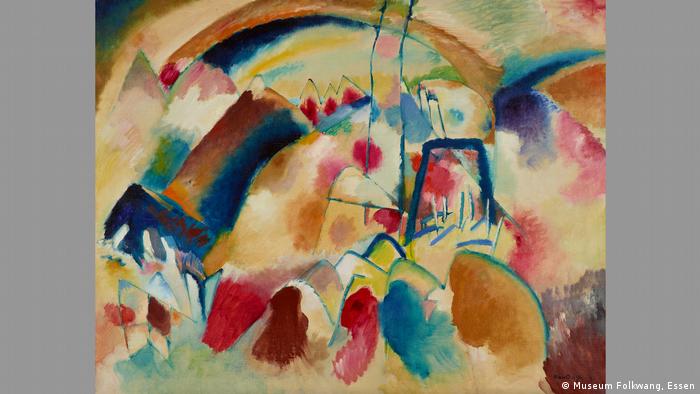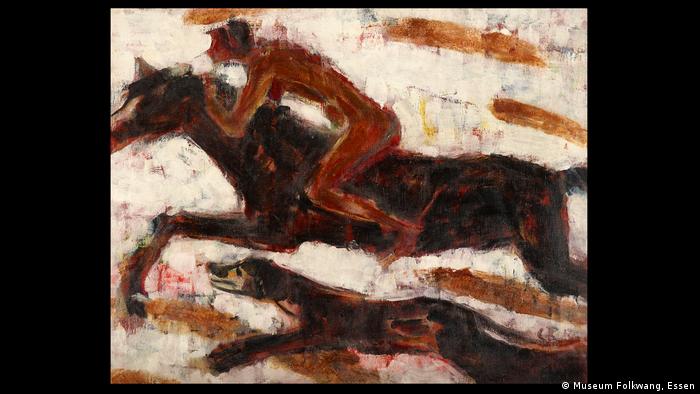Expressionism's rocky path from shunned to celebrated art
The art movement was considered "diseased" until Essen's Folkwang Museum rallied to the cause, buying and displaying the novel works. A new exhibition at Folkwang looks back at expressionism's early years.

The paintings are not finished at all, at best they are sloppily slapped together. On top of that, there are the garish, screaming colors. Houses are deep green, trees, flaming red. People are saffron yellow and horses are deep blue — outrageous.
That was the prevailing opinion of the public about the new style of painting at the beginning of the 20th century. Later the art movement would go down in history under the name expressionism. One of the first exhibitions of this style of painting was held at the Paris Salon as early as 1905. What Henri Matisse and other young artists exhibited there, shocked their contemporaries. An art critic gave them the name "les fauves" — the wild animals.
A response to social upheaval
The "Fauvists," forerunners of the expressionists, stood up against established art conventions. The official art establishment at the time was dominated by representative painting, and the imperial court in Germany supported painting that fitted in academic conventions.
Expressionist art rebelled against these entrenched traditions and focused on the social upheaval that was happening alongside the advance of industrialization. Art was a medium for painters to express their innermost feelings about the modern world; they wanted to stir things up emotionally. Among the most important representatives of this style were Henri Matisse, Emil Nolde, Franz Marc, Erich Heckel, August Macke and Ernst Ludwig Kirchner.
Long before the Nazis systematically campaigned against modern art, expressionist art was condemned as "degenerate."As early as 1913, for example, a Prussian member of parliament had passed around reproductions of Franz Marc's paintings and implored the Ministry of Culture "not to give any support to diseased art, that is, in particular not to make any purchases from museums... Because, gentlemen, we are dealing here with a direction which, from my layman's point of view, means degeneration, one of the symptoms of a sickly time."
A museum pioneer breaks new ground
But not everyone was hostile to the new art movement. That included Karl Ernst Osthaus, who founded the Museum Folkwang in the western German city of Hagen in the summer of 1902. As early as the winter of 1906/07, the painter Erich Heckel praised the art collector and patron as a "champion of all art that signifies a 'continuation' in development."
He asked Osthaus to exhibit works by the avant-garde artists' group "Brücke" and found his ears receptive. Franz Marc and the first exhibition of the group "Der Blaue Reiter" ("The Blue Rider") was also welcomed at the Museum Folkwang in 1911.
In Osthaus, the contemporary art scene had found an ally whom the painter Paula Modersohn-Becker had already praised in a letter to her sister in 1905: "The most beautiful thing for me in Hagen was the museum of a Mr Osthaus. He has gathered the latest art around him."
Osthaus not only gathered art in his exhibitions, he also bought it. The collector acquired paintings by the Viennese artists Oskar Kokoschka and Egon Schiele. This led to them being shown in a museum for the first time. The young art community was so grateful to the museum director that they presented him with a leather case filled with drawings and watercolors to mark the tenth anniversary of the Folkwang's founding.
Around 50 artists had participated, including Ernst Ludwig Kirchner, Max Pechstein, Wassily Kandinsky, August Macke, Emil Nolde, Franz Marc and Oskar Kokoschka.

Christian Rohlfs' 1912 "Amazone" (Amazon) is on display at the Folkwang Museum
New home in Essen
Fortunately for the expressionists, Karl Ernst Osthaus was not the only one with an eye for contemporary art. In the art museum of the city of Essen, he found an ally in its director, Ernst Gosebruch. The latter exhibited paintings by Emil Nolde in 1910 and noted enthusiastically at the time: "These are new — for Essen completely unheard-of — paths that this strange artist is taking."
When Karl Ernst Osthaus died in the spring of 1921 of tuberculosis, which he contracted during the First World War, Gosebruch brought his collection to Essen. The Hagen and Essen museums merged, and in 1922, the new Museum Folkwang was born.
But 11 years later, the open-mindedness for modern art was already over. When the Nazi Party came to power, Gosebruch was replaced in 1933 by a successor who was loyal to the regime. The expressionist artworks, which had been classified as "degenerate," were confiscated, and the museum building fell victim to a bombing raid later in the war.
True to Expressionism: 100 Years of the Folkwang
But it was not the end of the ambitious institution. As early as 1948, Folkwang once again put on an exhibition of expressionist artists at a different location.
The reconstruction of the collection began and today, 100 years after Osthaus opened his museum of modern art, many masterpieces from the expressionist movement can again be seen at the Folkwang Museum in the exhibition: "Discovered — Defamed — Celebrated."
The show runs from August 20, 2022 to January 8, 2023.
This article was originally written in German.

GABRIELE MÜNTER: MORE THAN A MUSE
Miss Ellen on the Grass (1934)
Clear forms, expressionist colors — the picture of the young woman sitting on the grass peeling potatoes shows Gabriele Münter's direct and self-confident painting style. But apparently this did not correspond to the beauty ideal of the National Socialists. Münter was banned from exhibiting the 1934 painting during the Nazi era.
12345678
Emil Nolde, the German expressionist 'degenerate' painter with Nazi convictions
One of the most important contributors to German expressionism, Emil Nolde is the focus of several exhibitions in Germany this year. Yet the chancellor's office has had his paintings removed due to his Nazi past.
No comments:
Post a Comment